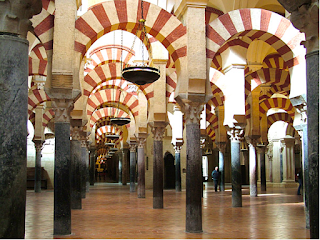The architecture of Andalusia has always fascinated me and I truly believe it is a perfect reflection of the relative harmony that existed between religious communities at the time in Spain. For example, if we look at The Great Mosque of Cordoba. Until it was converted into a mosque in 789 by Caliph Abd Al Rahman I, it was a Visigoth church. Abd Al Rahman kept intact the Roman columns of the building and the Visigothic arches *the red and white ones. He also used Christian Byzantine Artisans to embellish the mihrab of the mosque with gold and blue glass mosaic. Byzantine and Roman art was further meshed with Arabic calligraphic inscriptions which called for Islamic unity. Some historians would say the use of Roman and Byzantine influence was a clear show of Islamic supremacy politically through the building of the Mosque. However, regardless of the political desires, the Islamic rulers showed genuine regard for the skills of the Romans and Byzantines and the building is a clear meshing of 3 faiths and cultures. To this day, the Great Mosque of Cordoba is known by locals as the ‘’Mezquita-Catedral’’. In some ways then, the multiculturality of the building has tried to be preserved.
The amalgamation of cultural styles in Islamic art can clearly be seen in Mudejar art which appeared actually AFTER the Christian Reconquista of Spain. This form of art blending again three cultural styles was prevalent in Toledo. A perfect example is the Sinagogo del Transito built under the patronage of Samuel Halevi, leader of the Toledan Jewish community. It’s lace like window detail is very Islamic in influence, on the walls you see Arabic floral motifs interspersed with Christian shields of Castile and Leon. Therefore suggesting a purposeful blending of Christian and Isalmic techniques, thus suggesting cultural harmony in Al Andalus. Hebrew Jewish Calligraphy is also seen on the walls of the synagogue amongst intricate Islamic botanical plasterwork. The synagogue is indeed then a microcosm of three faiths’.
Cultural harmony between three faiths is also evident in the Alcazar of Seville, again built In the Mudejar syle in the mid 14th century. When Alfonso XI defeated the Islamic Marinids at he battle of Salado, he created the Alcazar’s Hall of Justice. In this hall, he included the heraldic shields of Castile and Leon, combined with a very Arabic fountain complete with floral motif and intricate calligraphy. The fact Alfonso XI freely chose to use Arabic decoration in tandem with Christian Emblems, shows his fascination with the Andalusi Arab culture, though arguably as well by using these influences perhaps he was trying to show an air of ‘’triumphalism’’ in his victory. However, later under the rule of King Pedro, the Alcazar was further ‘Arabized’’ as he used Nasrid ornamentation, wood carvings and intricate plaster stucco designs, similar to those found in the famous Alhambra. Moreover, the shahada, the Islamic declaration of faith ‘there is no God but God’ was also present on the walls of the Alcazar in Arabic, in and amongst symbols of Christianity and verses from the Gospel of St John. Thereby emphasing a cross cultural harmony as Artisans from Muslim Granada also worked on the construct.
For me, Andalucia architecturally is the perfect meshing and moulding together of the Abrahamic faiths of Islam, Christianity and Judaism, proving that coexistence and harmony can and ultimately has led to the most beautiful of creations. I would urge any eager traveller or lover of culture to visit Andalucia. Beauty is all around you in Al Andalus. This year, I hope to visit the Mezquita Catedral in Cordoba and the Alcazar In Seville.


